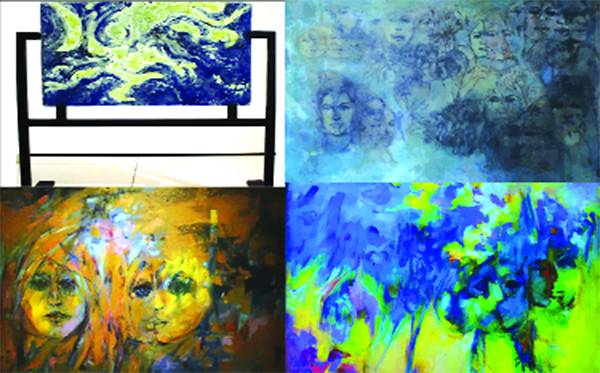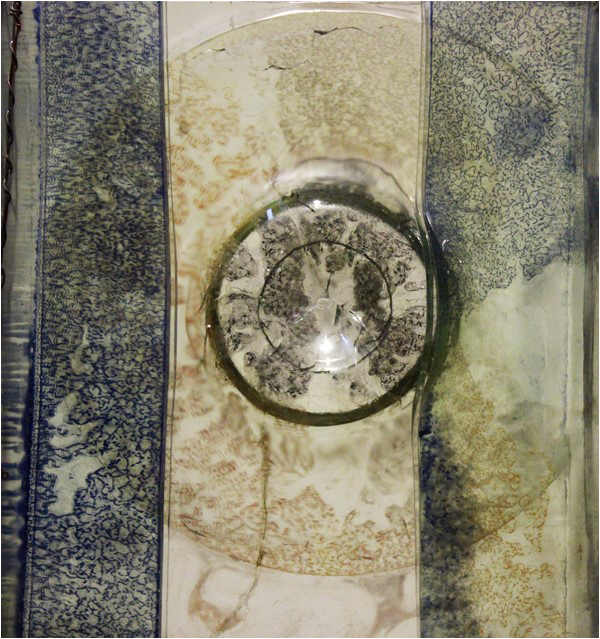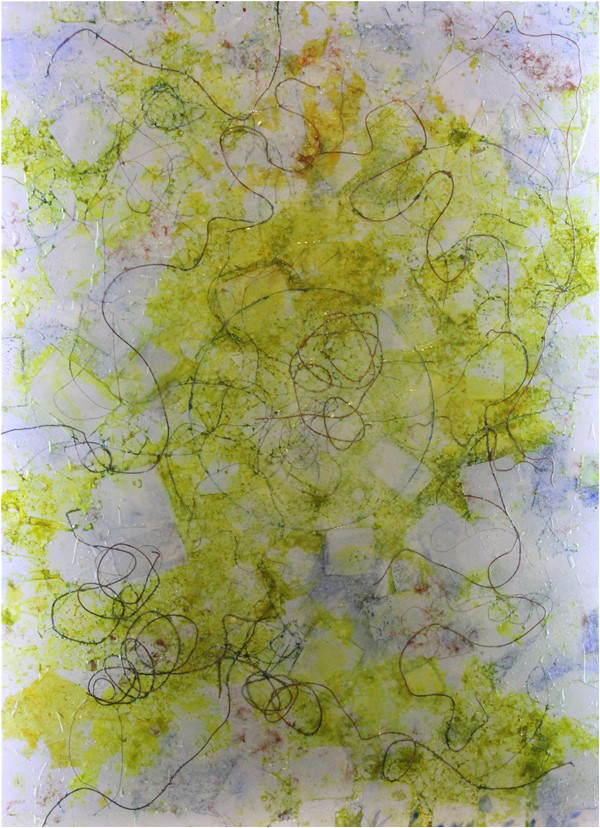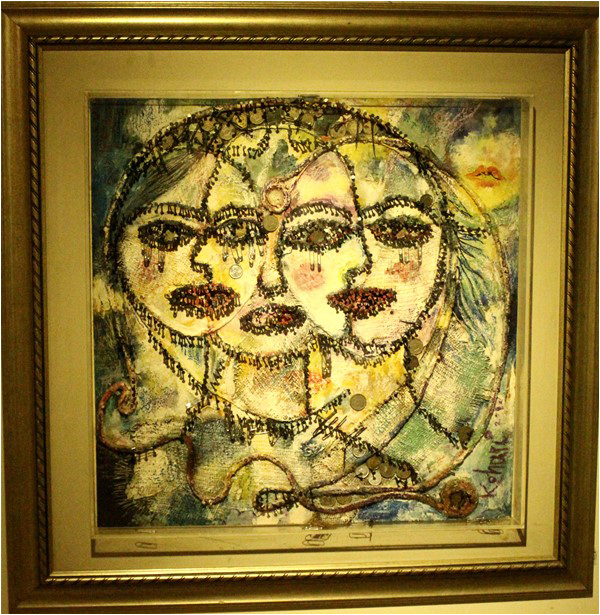
The history of the arts is full of accounts of various creative people who were not accepted in their day - artists, musicians and others. One example is Pakistan’s Masood Kohari, who has been living in Paris since 1969, having entered l’Ecole des Beaux Arts, and holding his first solo show of relief and collages at the Gallerie Mur du Nomade. He still comes to Pakistan to exhibit, while his drawings, paintings, ceramics and crystal collages are world famous. Actually, his work is rooted in ceramics, and he has been described as one of Pakistan’s finest artists. It was in Thatta that he started out as a ceramist. He began painting with oils on canvas in the 1960s, while continuing with ceramics.
But when he came to Pakistan in 1973, and lived and worked in Gujranwala with the local potters for three years, he was not at first well received by these people, since as a comfortably living city man, he had chosen to live in their mud houses, eat their simple food and sleep under the stars with their cows and buffaloes. Sometimes gaining acceptance takes time, but artists, musicians and others involved in creative pursuits carry on regardless – from the love of creating. So Masood Kohari kept on experimenting with various non-ceramic materials – clay, glass and glazes, resulting in ceramic collages which he called ‘Fire Paintings.’ While in France he had visited established glass studios and workshops, and from there he went to Italy’s famous glass centre in Marino, near Venice. The influence of these places formed the basis of his future work with glass.


Though he’s been part of the art scene for over 50 years, there have been times when he has found his breakthroughs unacknowledged and himself an outsider whose life and work seem to be irrelevant to the current art scene. In the decade after independence, Karachi had no art school, but he was able to share studio space with pioneers like Rasheed Araen, Nagi, Ajmal Hussain and Nasir Shamsi. Their work was mainly supported by people such as foreign diplomats – Karachi was then the country’s capital. The advice of eminent painter Shakir Ali to Masood was to “look beyond his immediate success” and these words remained in his heart. Thus he discovered a new medium – clay – and its lifelong exploration. And therefore, to work with clay he forsook Karachi for the pottery workshops of the aforementioned Gujranwala, and Gujrat too – working in both places with rudimentary facilities.
In such places the work was really ancestral. But as a dedicated, forward-looking artist he continued to experiment, to collapse boundaries and and allow space for exploration – as, for example, when he first collected scraps of rusted wire mesh from piles of waste glass and buried them in the surfaces of thickly glazed tiles. This was the beginning of his fire paintings – also called fire collages – in rich colours, and won him critical acclaim plus the Shakir Ali Award. The texture was achieved by melting powdered glass in an oven, then allowing it to cool slowly to avoid cracks. Recently, besides the powdered glass, he has used wire netting, various colours and chemicals, topped with another piece of glass. In the oven, various materials fuse to create beautiful textures – air bubbles and other features that interact with light passing through the patterns. He himself refers to “the highly dicey, tricky and uncanny situation of rapidly changing heat in a kiln.” Glass particles are never still, and are constantly responding to the ambient heat in the kiln, just as the atoms in all creation are constantly changing. And incidentally, this is one of the reasons why His Holiness the Dalai Lama and other Buddhist teachers tell us that it is fruitless to look for a permanent self.
Considering its romantic history amongst other things, it is no wonder that Masood Kohari has found glass a fascinating medium to work with, or that he named his recent show at Karachi’s Chawkandi Gallery ‘Tranceaparance’. Seeing this word that he has coined, one can imagine him working feverishly in a creative trance.
At Chawkandi, Kohari presented quite a number of glass pieces, as well as paintings. One of these pieces is a handsome creation divided into 3 panels of crystals of different colours in a black frame, while in the central piece a black circle encompasses its own contingent. This is quite a feat, for the artist to get the glass fragments to behave more or less as he wished while being fired, and otherwise handled. The piece exhibits subtlety, texture, light and excellent balance.
Another excellent piece features clearly visible crystals in green, surrounded by others of pale blue, and one can see clearly the curving road marked out by the wire scraps, some neatly finishing as they move towards the edges. Yes, there is movement in this composition. And it is somehow like a maze, with the wire pieces indicating various points of entry and exit.

Masood’s piece featuring a curving, marbled effect with pale green crystals swimming in a dark blue background set on a standing black frame is quite attractive, though the proportional contrast between frame and picture makes the latter seem somewhat truncated. Then an entertaining piece, maybe somewhat whimsical, suggests the little plastic bags of goldfish that children take home from the local pet shop, and one could say that it comes complete with the wire netting used to catch the fish. The colour graduation is an attractive feature.
Amongst his face paintings is one which strongly suggests King Richard III’s dream the night before his last, fateful battle – the Battle of Bosworth Field – as portrayed in the wonderful movie based on Shakespeare’s Richard III. Against the smoky blue-grey of the battlefield the faces of all those whom he has harmed in his lifetime appear one by one, saying, “Tomorrow on the battlefield think on me, despair and die!” However, whereas Richard’s victims were mostly male, Kohari’s faces here are mostly female, their graceful hands adding beauty to the scene, while in the centre a small group of dainty female figures seems about to take off. All rather more innocent than the circumstances painted by Shakespeare.
It is disappointing to see an artist, even if well respected, producing an endless series of similar faces, but the variety of Kohari’s faces is impressive. Quite engaging is the piece featuring two beautiful girls’ faces surrounded by an interrupted circle, mostly composed of dark-coloured glass beads. It’s a piece full of ingenuity, since these beads appear everywhere – even making up the facial features, particularly the large and beautiful eyes, while the wire that forms the circle ends like a signature at the bottom of the picture. The piece is much enhanced by its skillful framing.
Here and there the face pictures have a character due to bold splashes of colour. In one or two one must look carefully within this colour to see the faces. But there’s one multicoloured piece – somehow a little mysterious – where two large-eyed girls appear on either side of what could be taken for a brown tree trunk, with blue irises above between the girls’ foreheads, and a small textured area above all. And from the centre to the outer edges the colours gradually fade, so that the subject stands out clearly.
Nearby is a work in which the uninhibited display of blue combined with areas of green is a picture in itself. But Masood has cleverly included 4-5 partial faces. Not that they are beautiful in terms of art, but in the galleries of today the subject, once you’ve found it, could be described as fascinating. French biologist and philosopher Jean Rostand has declared, “Beauty is nothing but ugliness subdued.” This is very true in much of today’s art – perhaps even of some of Kohari’s face renditions. And many works that would have been laughed out of the galleries in the past are now much in demand.
Some artists soon gain the recognition that they deserve. Others, like Masood Kohari, have had to wait for their laurels – and it was his outstanding work in glass that brought him to the fore.
The author lives in Karachi. She devoted 17 years to classical Kathak, has been writing about books and art for many years and is a student of Tibetan Buddhism
But when he came to Pakistan in 1973, and lived and worked in Gujranwala with the local potters for three years, he was not at first well received by these people, since as a comfortably living city man, he had chosen to live in their mud houses, eat their simple food and sleep under the stars with their cows and buffaloes. Sometimes gaining acceptance takes time, but artists, musicians and others involved in creative pursuits carry on regardless – from the love of creating. So Masood Kohari kept on experimenting with various non-ceramic materials – clay, glass and glazes, resulting in ceramic collages which he called ‘Fire Paintings.’ While in France he had visited established glass studios and workshops, and from there he went to Italy’s famous glass centre in Marino, near Venice. The influence of these places formed the basis of his future work with glass.


Though he’s been part of the art scene for over 50 years, there have been times when he has found his breakthroughs unacknowledged and himself an outsider whose life and work seem to be irrelevant to the current art scene. In the decade after independence, Karachi had no art school, but he was able to share studio space with pioneers like Rasheed Araen, Nagi, Ajmal Hussain and Nasir Shamsi. Their work was mainly supported by people such as foreign diplomats – Karachi was then the country’s capital. The advice of eminent painter Shakir Ali to Masood was to “look beyond his immediate success” and these words remained in his heart. Thus he discovered a new medium – clay – and its lifelong exploration. And therefore, to work with clay he forsook Karachi for the pottery workshops of the aforementioned Gujranwala, and Gujrat too – working in both places with rudimentary facilities.
In such places the work was really ancestral. But as a dedicated, forward-looking artist he continued to experiment, to collapse boundaries and and allow space for exploration – as, for example, when he first collected scraps of rusted wire mesh from piles of waste glass and buried them in the surfaces of thickly glazed tiles. This was the beginning of his fire paintings – also called fire collages – in rich colours, and won him critical acclaim plus the Shakir Ali Award. The texture was achieved by melting powdered glass in an oven, then allowing it to cool slowly to avoid cracks. Recently, besides the powdered glass, he has used wire netting, various colours and chemicals, topped with another piece of glass. In the oven, various materials fuse to create beautiful textures – air bubbles and other features that interact with light passing through the patterns. He himself refers to “the highly dicey, tricky and uncanny situation of rapidly changing heat in a kiln.” Glass particles are never still, and are constantly responding to the ambient heat in the kiln, just as the atoms in all creation are constantly changing. And incidentally, this is one of the reasons why His Holiness the Dalai Lama and other Buddhist teachers tell us that it is fruitless to look for a permanent self.
To work with clay, he forsook Karachi for the pottery workshops of Gujranwala and Gujrat
Considering its romantic history amongst other things, it is no wonder that Masood Kohari has found glass a fascinating medium to work with, or that he named his recent show at Karachi’s Chawkandi Gallery ‘Tranceaparance’. Seeing this word that he has coined, one can imagine him working feverishly in a creative trance.
At Chawkandi, Kohari presented quite a number of glass pieces, as well as paintings. One of these pieces is a handsome creation divided into 3 panels of crystals of different colours in a black frame, while in the central piece a black circle encompasses its own contingent. This is quite a feat, for the artist to get the glass fragments to behave more or less as he wished while being fired, and otherwise handled. The piece exhibits subtlety, texture, light and excellent balance.
Another excellent piece features clearly visible crystals in green, surrounded by others of pale blue, and one can see clearly the curving road marked out by the wire scraps, some neatly finishing as they move towards the edges. Yes, there is movement in this composition. And it is somehow like a maze, with the wire pieces indicating various points of entry and exit.

Masood’s piece featuring a curving, marbled effect with pale green crystals swimming in a dark blue background set on a standing black frame is quite attractive, though the proportional contrast between frame and picture makes the latter seem somewhat truncated. Then an entertaining piece, maybe somewhat whimsical, suggests the little plastic bags of goldfish that children take home from the local pet shop, and one could say that it comes complete with the wire netting used to catch the fish. The colour graduation is an attractive feature.
Amongst his face paintings is one which strongly suggests King Richard III’s dream the night before his last, fateful battle – the Battle of Bosworth Field – as portrayed in the wonderful movie based on Shakespeare’s Richard III. Against the smoky blue-grey of the battlefield the faces of all those whom he has harmed in his lifetime appear one by one, saying, “Tomorrow on the battlefield think on me, despair and die!” However, whereas Richard’s victims were mostly male, Kohari’s faces here are mostly female, their graceful hands adding beauty to the scene, while in the centre a small group of dainty female figures seems about to take off. All rather more innocent than the circumstances painted by Shakespeare.
It is disappointing to see an artist, even if well respected, producing an endless series of similar faces, but the variety of Kohari’s faces is impressive. Quite engaging is the piece featuring two beautiful girls’ faces surrounded by an interrupted circle, mostly composed of dark-coloured glass beads. It’s a piece full of ingenuity, since these beads appear everywhere – even making up the facial features, particularly the large and beautiful eyes, while the wire that forms the circle ends like a signature at the bottom of the picture. The piece is much enhanced by its skillful framing.
Here and there the face pictures have a character due to bold splashes of colour. In one or two one must look carefully within this colour to see the faces. But there’s one multicoloured piece – somehow a little mysterious – where two large-eyed girls appear on either side of what could be taken for a brown tree trunk, with blue irises above between the girls’ foreheads, and a small textured area above all. And from the centre to the outer edges the colours gradually fade, so that the subject stands out clearly.
Nearby is a work in which the uninhibited display of blue combined with areas of green is a picture in itself. But Masood has cleverly included 4-5 partial faces. Not that they are beautiful in terms of art, but in the galleries of today the subject, once you’ve found it, could be described as fascinating. French biologist and philosopher Jean Rostand has declared, “Beauty is nothing but ugliness subdued.” This is very true in much of today’s art – perhaps even of some of Kohari’s face renditions. And many works that would have been laughed out of the galleries in the past are now much in demand.
Some artists soon gain the recognition that they deserve. Others, like Masood Kohari, have had to wait for their laurels – and it was his outstanding work in glass that brought him to the fore.
The author lives in Karachi. She devoted 17 years to classical Kathak, has been writing about books and art for many years and is a student of Tibetan Buddhism

